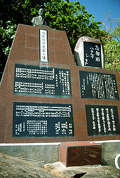During the Battle of Okinawa, the other islands where the U.S. forces did not land such as on the Sakishima Islands (Sakishima, Miyako-jima Island, and the Yaeyama Island group) also experienced great sacrifices.
On Sakishima there was considerable damage from the aerial bombardment of the U.S. and British navies but, the most serious damage was caused by lack of food and malaria.
On Yaeyama, the people were forced to leave their homes and go into the mountainous areas. 3,647 people, about 11% of the population, contracted and died of malaria. The six thousand residents of Miyako-jima Island had over three thousand troops stationed there and suffered extreme food shortages and malaria.
On Izena-jima Island on the northern coast of the Okinawa mainland , three U.S. servicemen cast ashore were executed under orders by Japanese soldiers, who then went on to kill the nearby villagers. The islands of Iheya-jima and Aguni-jima had no Japanese troops stationed there and the U.S. forces landed smoothly and there were effectively no great losses of life. Residents were able to surrender smoothly to U. S. forces as a result. The presence or absence of Japanese troops determined the extent of the casualties suffered by the civilian residents. On the small island Sesoko-jima, on the north coast of Okinawa, the residents, fearing the casualties caused by the presence of Japanese troops, repelled the Japanese soldiers that had crossed over to escape from the main island.
The presence of bomber base on Tsuken-jima in the Nakagusuku Gulf meant that this area became one of intense fighting. On Tonaki-jima Island, communications were cut with the mainland of Okinawa, residents were forced to endure starvation until the news of the end of the war reached there in the middle of September.

"Wasurena-ishi" Malaria Victim Memorial on Iriomote-jima Island

Yaeyama War Memorial for Malaria Victims.

